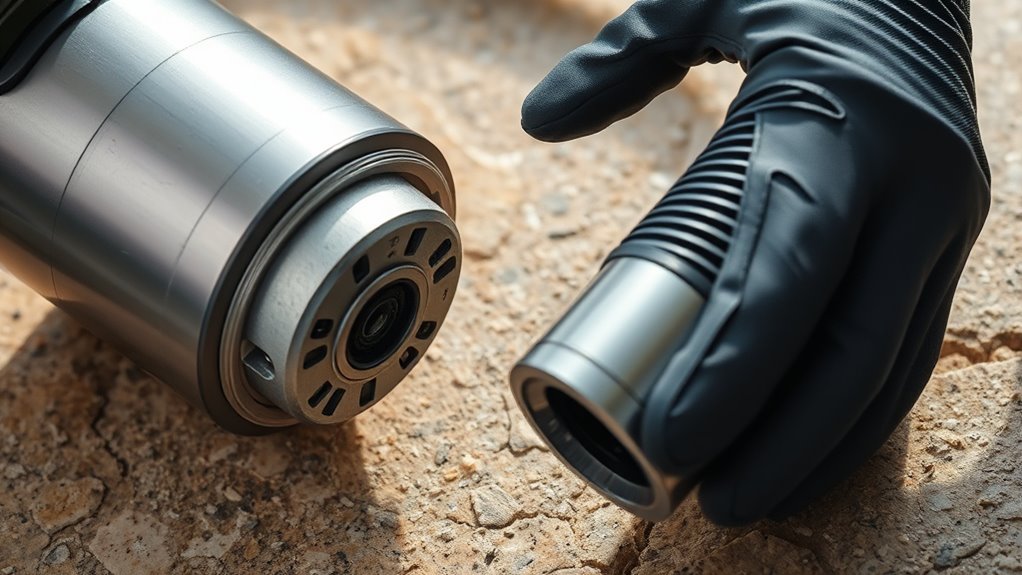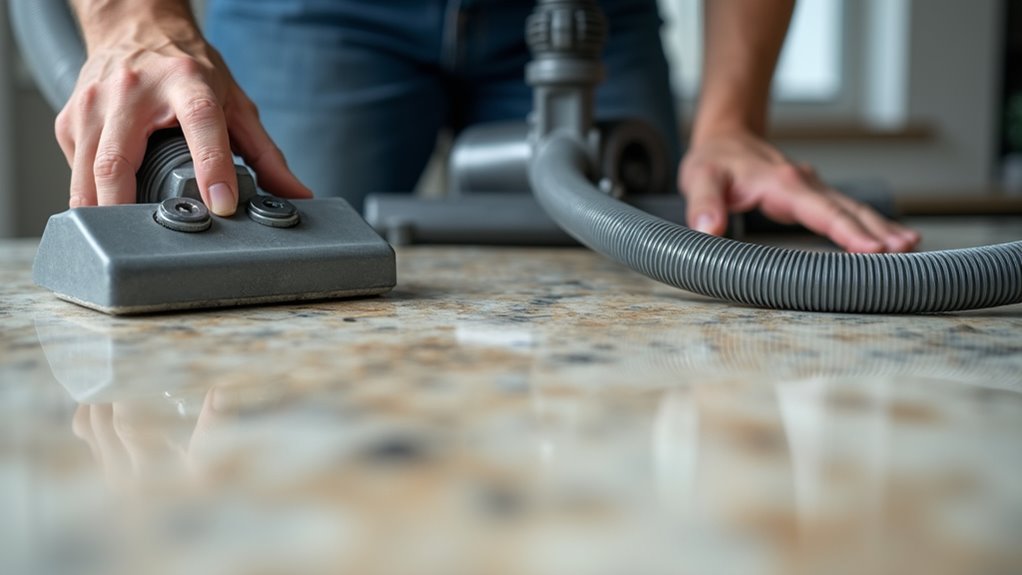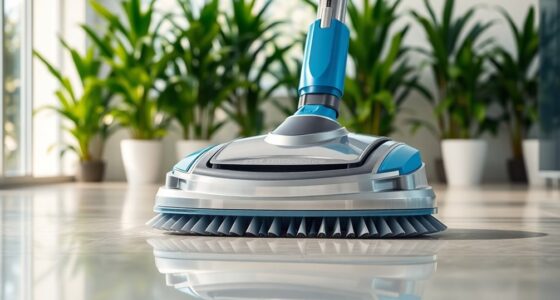If your vacuum isn’t picking up on natural stone, start by checking the motor for unusual sounds or dust buildup that could signal a problem. Inspect the hose for cracks, debris, or obstructions, and make sure all fittings are secure and free from leaks. Clearing blockages and ensuring proper airflow can make a big difference in suction. To keep your vacuum performing well, there are more simple checks and tips you can try.
Key Takeaways
- Inspect the vacuum hose for cracks, tears, or obstructions that may block debris pickup on natural stone surfaces.
- Check the motor sounds for unusual noises indicating potential motor issues affecting suction power.
- Ensure all hose fittings are secure and free of dust or debris to maintain optimal airflow.
- Clean or replace filters regularly to prevent airflow restrictions that reduce debris pickup.
- Confirm the motor housing is free of dust buildup and debris to keep the vacuum operating effectively.

Regularly checking your vacuum motor and hose is vital to prevent damage when cleaning natural stone surfaces. If your vacuum isn’t picking up debris like it used to, it’s time to investigate the motor and hose. Proper vacuum motor maintenance ensures your equipment runs efficiently, reducing the risk of burnout or failure. Start by listening carefully when you turn the vacuum on. If the motor sounds strained, loud, or inconsistent, it could indicate a problem. Dust buildup or debris inside the motor housing can impede airflow, causing the motor to work harder and potentially overheat. Cleaning or replacing filters regularly helps maintain proper airflow, which is essential for vacuum motor health. Also, check that the motor’s vent openings are clear of dust and obstructions, as blocked vents can cause overheating and reduce suction power.
In addition, incorporating performance upgrades such as improved filters or motor components can enhance your vacuum’s efficiency and longevity. Hose inspection tips are equally important. A damaged or clogged hose can profoundly decrease your vacuum’s suction, making it seem like the motor isn’t functioning properly. Start by visually inspecting the hose for cracks, tears, or punctures. Even small holes can cause a loss of suction, and if you notice debris lodged inside, it can block airflow entirely. To clear obstructions, detach the hose and run water through it if it’s washable, or use a long, flexible brush to dislodge debris. Ensure the hose connectors are secure and free of debris, as loose fittings can leak air and diminish suction power. When inspecting, also check for any kinks or bends that restrict airflow; straighten these out to restore proper suction.
If you notice persistent suction issues despite cleaning the hose and maintaining the motor, it might be time to replace worn-out parts. Regular maintenance saves you money in the long run by preventing costly repairs or replacements. Keep in mind that natural stone surfaces are delicate, so using a vacuum with a well-maintained motor and a clean, intact hose prevents scratching or damaging the surface during cleaning. Implementing routine vacuum maintenance and hose inspection tips ensures your equipment stays in top shape and keeps your natural stone surfaces spotless and undamaged. By staying vigilant, you can catch issues early, avoid downtime, and extend the lifespan of your vacuum cleaner, making your cleaning process more efficient and effective.
Frequently Asked Questions
How Often Should Vacuum Motors Be Maintained?
You should maintain your vacuum motors regularly, ideally following a maintenance schedule every three to six months. Performance monitoring helps identify signs of wear or reduced efficiency early, preventing breakdowns. By consistently checking and maintaining your vacuum motors, you guarantee peak performance and longevity. Don’t forget to inspect hoses and filters during each maintenance session to keep your system running smoothly and avoid unexpected issues.
What Are Signs of a Failing Vacuum Motor?
You’ll notice a failing vacuum motor when it starts making unusual noises—like grinding or high-pitched whines—that signal motor noise symptoms. With an average vacuum motor lifespan of around 3 to 5 years, ignoring these signs can lead to reduced suction and costly repairs. If your vacuum isn’t picking up like it used to, or if it sounds different, it’s time to check the motor and consider replacement before more damage occurs.
Can Hose Damage Affect Cleaning Performance?
Yes, hose damage can affect your cleaning performance. If your hose isn’t durable or gets cracks, holes, or blockages, it restricts airflow, reducing suction power. This directly impacts cleaning efficacy, making it harder to pick up dirt and debris. Regularly inspect your hose for wear and tear, replacing it if necessary, to guarantee peak vacuum function and maintain efficient cleaning results.
Are There Safety Concerns With Vacuum Motor Repairs?
Yes, there are safety concerns with vacuum motor repairs. You should prioritize electrical safety by unplugging the device before starting repairs. Follow repair precautions like wearing insulated gloves and using proper tools to avoid electrical shocks or damage. If you’re unsure or uncomfortable, it’s best to consult a professional. Taking these steps guarantees your safety while maintaining your vacuum’s performance.
What Tools Are Needed for Hose Replacement?
Did you know that over 60% of vacuum motor repairs involve hose issues? For hose replacement, you’ll need basic tools like screwdrivers, pliers, and possibly a utility knife. These hose replacement tools help you disconnect old hoses and secure new ones properly. When performing vacuum motor repair, having the right tools guarantees a smooth process, minimizes damage, and gets your equipment back to peak performance quickly.
Conclusion
If your vacuum still won’t pick up after these checks, it’s like trying to tame a wild beast with a feather—completely hopeless! Don’t settle for a cleaning tool that’s more drama than help. Take action now, because a powerful vacuum can turn your natural stone surfaces from a stubborn mess into a spotless masterpiece in seconds. Don’t let a little trouble hold you back—conquer your cleaning challenges before they conquer you!









